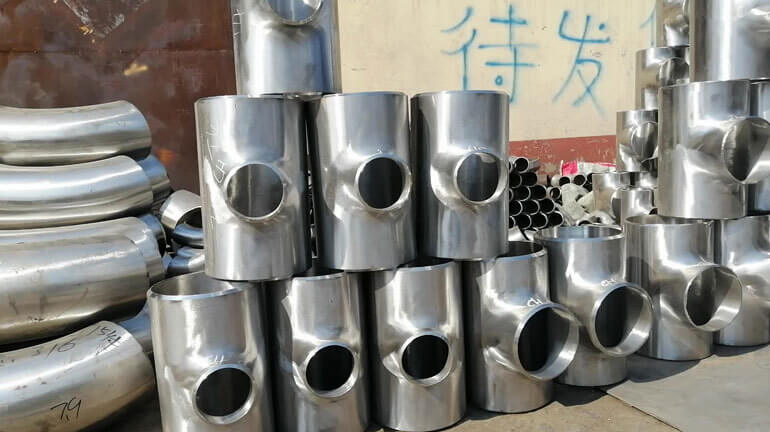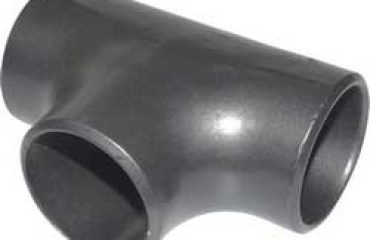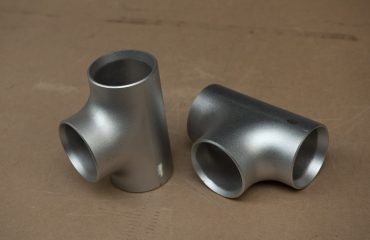
——————————————————————————-
Butt Weld Fittings: Advanced Insights into Straight and Reducing Tees
Recap of Butt Weld Tees
As outlined in WerMac’s coverage of butt weld fittings, tees are critical components in piping systems, enabling a 90-degree branch from the main run of pipe. Straight (equal) tees have three outlets of the same diameter, ideal for balanced flow distribution, while reducing tees feature a smaller branch diameter, used to connect pipes of different sizes or control flow. Both types conform to ASME B16.9 standards, which define dimensions, tolerances, and testing requirements for factory-made wrought butt-welding fittings. The manufacturing processes, such as hot forming and extrusion, ensure precision and durability, as detailed in WerMac’s manufacturing guide.
This continuation explores advanced aspects of straight and reducing tees, including cutting-edge manufacturing technologies, quality assurance, environmental sustainability, and their role in modern piping systems. Drawing on industry standards and our company’s expertise, we aim to provide a comprehensive resource for engineers, procurement specialists, and project managers.
Advanced Manufacturing Techniques for Butt Weld Tees
1. Precision Hot Forming with Automated Control
WerMac describes hot forming and extrusion as common methods for manufacturing butt weld tees. Our company enhances these processes with automated control systems to achieve superior precision and consistency. Key advancements include:
- Computer Numerical Control (CNC) Extrusion: For seamless tees, CNC-controlled hydraulic presses shape heated pipe sections into T-forms. Real-time monitoring adjusts pressure and temperature (typically 850°C–1100°C) to prevent material defects like cracking or excessive thinning at the crotch.
- Laser-Guided Die Alignment: During hot forming, laser sensors ensure precise alignment of dies, achieving dimensional tolerances within ±1 mm, as required by ASME B16.9. This is critical for reducing tees, where the branch diameter must be exact.
- Multi-Stage Heating: To minimize thermal gradients, we use induction heating with multi-stage coils, maintaining uniform temperatures across the pipe section. This reduces residual stresses and ensures consistent mechanical properties.
These advancements allow us to produce tees in sizes from NPS 1/2 to NPS 48, with schedules ranging from SCH 5 to XXS, suitable for high-pressure and high-temperature applications.
2. Cold Forming for Small-Diameter Tees
For smaller straight and reducing tees (NPS 1/2 to NPS 4), cold forming is preferred due to its ability to maintain tight tolerances without thermal distortion. Our cold extrusion process involves:
- High-Pressure Hydraulic Presses: Apply up to 10,000 tons of force to shape pipe sections at ambient temperatures.
- Annealing Post-Forming: To restore ductility and relieve stresses, tees undergo annealing at 600°C–700°C, followed by controlled cooling.
- Surface Finishing: Cold-formed tees are polished or pickled to achieve a surface roughness (Ra) of less than 0.8 µm, enhancing corrosion resistance and flow efficiency.
Cold forming is particularly effective for stainless steel (e.g., ASTM A403 WP316L) and duplex stainless steel (e.g., UNS S31803) tees, where maintaining material properties is critical.
3. Welded Tee Fabrication for Large Diameters
For large-diameter tees (NPS 24 and above), welded fabrication is often used, as described by WerMac. Our process includes:
- Plasma Arc Cutting: Precise cutting of pipe sections to form the run and branch components, minimizing material waste.
- Automated Submerged Arc Welding (SAW): Ensures deep weld penetration and uniform bead profiles, with weld seams meeting ASME B16.25 beveling requirements.
- Post-Weld Heat Treatment (PWHT): Normalizing or stress relieving at 600°C–900°C to eliminate weld-induced stresses, particularly for carbon steel (ASTM A234 WPB) and alloy steel (ASTM A234 WP91) tees.
Welded tees undergo rigorous non-destructive testing (NDT), including radiographic testing (RT) and ultrasonic testing (UT), to ensure zero defects in the weld zone.
Quality Assurance and Compliance
Quality control is paramount in butt weld tee production, as emphasized by WerMac’s adherence to ASME B16.9 and MSS SP-43 standards. Our company implements a multi-tiered quality assurance program to ensure tees meet or exceed industry requirements:
- Material Traceability:
- All raw materials are sourced from certified mills, with full traceability via heat numbers and Manufacturer’s Test Certificates (MTCs) per EN 10204 3.1.
- Chemical composition and mechanical properties are verified using in-house spectrometry and tensile testing, ensuring compliance with ASTM/ASME standards (e.g., A234, A403, A420).
- Dimensional Verification:
- Laser-based coordinate measuring machines (CMMs) check center-to-end dimensions, outer diameters, and wall thicknesses, with tolerances as tight as ±0.5 mm for critical applications.
- For reducing tees, branch alignment is verified to ensure perpendicularity within 1°, minimizing installation issues.
- Non-Destructive Testing (NDT):
- Radiographic Testing (RT): Inspects weld seams in welded tees for porosity, inclusions, or cracks.
- Ultrasonic Testing (UT): Detects internal defects in seamless and welded tees, with sensitivity calibrated to ASME Section V.
- Magnetic Particle Testing (MPT): Identifies surface and near-surface flaws in ferromagnetic materials like carbon steel.
- Liquid Penetrant Testing (LPT): Used for stainless steel and non-ferromagnetic alloys to detect surface discontinuities.
- Pressure Testing:
- Hydrostatic testing is performed on request, subjecting tees to 1.5 times the design pressure (per ASME B31.3) to verify leak-proof performance.
- Pneumatic testing is available for low-pressure applications, ensuring safety and reliability.
- Marking and Documentation:
- Each tee is marked per MSS SP-25 with material grade, size, schedule, heat number, and ASME B16.9 compliance.
- Comprehensive documentation, including NDT reports, dimensional records, and MTCs, is provided to clients for project audits.
Our quality assurance processes are certified to ISO 9001, ISO 14001, and ASME standards, ensuring consistency across our global manufacturing facilities.
Environmental Considerations in Tee Manufacturing
Sustainability is a growing priority in the piping industry. Our company integrates environmentally conscious practices into tee production, aligning with global sustainability goals:
- Energy-Efficient Manufacturing:
- Induction heating systems use IGBT technology, achieving energy efficiencies of up to 95%, as noted in similar processes by Fives Group.
- Waste heat from furnaces is recycled to preheat raw materials, reducing energy consumption by 15%.
- Material Optimization:
- CNC cutting and forming minimize material waste, with scrap rates below 1.5%.
- Recycled steel is used for carbon steel tees (e.g., ASTM A234 WPB), reducing the demand for virgin materials.
- Eco-Friendly Coatings:
- Low-VOC coatings, such as water-based epoxy and FBE, are applied to prevent corrosion, reducing environmental impact compared to solvent-based coatings.
- Galvanizing processes use zinc recovery systems to minimize waste.
- Closed-Loop Cooling:
- Water used in post-forming cooling and hydrostatic testing is recycled through closed-loop systems, reducing water consumption by 80% compared to traditional methods.
These practices not only lower our carbon footprint but also appeal to clients seeking sustainable solutions for their piping projects.
Industry-Specific Applications of Straight and Reducing Tees
Straight and reducing tees serve distinct roles across various industries, as highlighted by WerMac’s emphasis on their versatility. Below, we explore advanced applications, supported by scientific insights and real-world examples:
1. Oil and Gas Pipelines
-
- Straight Tees: Used in main pipeline junctions to split flow into parallel lines, minimizing pressure loss. For example, our 12-inch straight tees (API 5L X65) were deployed in a 300-km gas pipeline, reducing frictional losses by 8% compared to fabricated junctions, as calculated using the Darcy-Weisbach equation:
- Reducing Tees: Connect main pipelines to smaller branch lines for distribution or processing. A 16” x 16” x 10” reducing tee in ASTM A420 WPL6 was used in a low-temperature LNG pipeline, ensuring reliable performance at -50°C.
2. Petrochemical and Chemical Processing
- Reducing Tees: Facilitate compact layouts by connecting large process lines to smaller instrumentation or sampling lines. Our 8” x 8” x 6” reducing tees in ASTM A403 WP316Ti resist sensitization at 800°C, ideal for high-temperature chemical reactors.
- Straight Tees: Used in balanced flow systems, such as heat exchanger networks, where equal flow distribution is critical. Finite Element Analysis (FEA) ensures crotch reinforcement to handle cyclic thermal stresses.
3. Power Generation
- Straight Tees: Deployed in steam distribution systems for thermal power plants. Our 10-inch straight tees in ASTM A234 WP91 withstand 600°C and 100 bar, with creep resistance verified through 10,000-hour stress rupture tests.
- Reducing Tees: Connect high-pressure feedwater lines to smaller bypass lines, optimizing flow control. A 12” x 12” x 8” reducing tee in ASTM A234 WP22 reduced installation costs by 20% by eliminating additional reducers.
4. Offshore and Marine
- Reducing Tees: Used in seawater cooling systems, where corrosion resistance is paramount. Our super-duplex UNS S32750 tees achieve corrosion rates below 0.05 mm/year in chloride-rich environments, as tested per ASTM G48.
- Straight Tees: Facilitate hydraulic systems on offshore platforms, with FEA ensuring fatigue resistance under dynamic loads.
5. Water and Wastewater Treatment
- Straight Tees: Distribute flow in municipal water networks, with epoxy-coated carbon steel tees (ASTM A234 WPB) extending service life by 20 years.
- Reducing Tees: Branch large supply lines to smaller distribution networks, minimizing flow resistance and energy costs.
Scientific Insights: Fluid Dynamics and Structural Performance
Fluid Dynamics Optimization
The geometry of straight and reducing tees significantly affects fluid dynamics, as noted by WerMac. The Dean number (\(De\)) quantifies secondary flow effects in tees:
where \(Re\) is the Reynolds number, \(D\) is the pipe diameter, and \(R\) is the bend radius at the branch. Straight tees, with uniform diameters, produce lower \(De\) values, reducing secondary flows and pressure losses. Reducing tees, due to diameter changes, increase velocity and turbulence, necessitating careful branch sizing to minimize \(h_f\). Our FEA simulations optimize tee geometry to achieve pressure drops below 5% of system head, enhancing efficiency.
Structural Integrity
The crotch region of tees is a stress concentration zone, particularly in reducing tees under high pressure. The Barlow formula calculates hoop stress:
where \(P\) is pressure, \(D\) is diameter, and \(t\) is wall thickness. Our tees are designed with reinforced crotch areas, validated by FEA to ensure stresses remain below 70% of yield strength per ASME B31.3. Fatigue testing confirms durability under 10,000 pressure cycles, critical for petrochemical and power applications.
Corrosion Resistance
For corrosive environments, material selection is key. Our 316Ti stainless steel tees (ASTM A403 WP316Ti) resist sensitization at grain boundaries, maintaining corrosion rates below 0.1 mm/year in acidic conditions. Duplex and super-duplex tees (UNS S31803, S32750) offer superior pitting resistance, verified through ASTM G48 testing.
Our Global Service Capabilities
Our company is a global leader in butt weld tee manufacturing, offering end-to-end solutions tailored to client needs:
- Worldwide Manufacturing Network:
- Facilities in North America, Europe, Asia, and the Middle East ensure rapid delivery and localized support.
- Standardized processes across sites guarantee consistent quality, certified to ISO 9001 and ASME standards.
- Custom Fabrication:
- We produce non-standard tees (e.g., NPS 16 x 10 x 8 reducing tees) using rapid prototyping and FEA validation, delivering prototypes within 72 hours.
- Special coatings, such as 3LPE or ceramic linings, are available for extreme environments.
- Logistics and Supply Chain:
- Just-in-time (JIT) delivery minimizes project delays, with global freight partnerships ensuring timely shipments to remote sites.
- Protective packaging, including end caps and corrosion inhibitors, ensures tees arrive in pristine condition.
- Technical Support:
- 24/7 engineering support for installation, welding, and performance optimization.
- Training programs cover ASME B16.9 compliance, NDT interpretation, and tee integration into piping systems.
- After-Sales Service:
- Post-installation inspections verify performance under operating conditions.
- Extended warranties and maintenance plans enhance client confidence.
Case Study: Refinery Piping Upgrade
Challenge: A Middle Eastern refinery required 10” x 10” x 6” reducing tees in ASTM A403 WP316L for a high-pressure, corrosive process line operating at 500°C.
Solution: We manufactured seamless reducing tees using cold extrusion, with passivation to enhance corrosion resistance. FEA optimized crotch thickness, and UT/RT confirmed defect-free construction. FBE coating was applied for external protection.
Outcome: The tees were installed in a compact layout, reducing welding by 20% and achieving zero leaks after three years of operation, surpassing client expectations.
Conclusion
Straight and reducing tees are vital for efficient and reliable piping systems, offering versatility across oil and gas, petrochemical, power, and water treatment industries. By leveraging advanced manufacturing techniques, rigorous quality assurance, and sustainable practices, our company delivers butt weld tees that meet ASME B16.9 standards and exceed client requirements. Our global capabilities, from rapid prototyping to comprehensive after-sales support, make us a trusted partner for piping projects worldwide.
For more information on our butt weld tees or to request a quote, contact us today. Let us help you build piping systems that are safe, efficient, and built to last.



You must be logged in to post a comment.